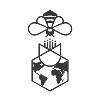Bee.otany hopes to educate beekeepers, public, and others who want to #savethebees into understanding what flowering plants and trees help honeybees and other pollinators. By specializing in place and language of flowering plants for pollinators it allows everyone to be part of the solution to #plantforbees to #planttheseed to #helppollinators and #changetheworld
Organizational History and Mission Statement
Bee.otany established in 2018, is a US based 501(c)(3) nonprofit organization located in Minnesota, USA. The mission of the organization is dedicated to education, research, and charitable programming that promotes pollinator habitat through collaboration to capture local knowledge and promote sustainability. Bee.otany specializes in research and learning about pollinators and their habitat through accessible experimental education and tools that assist in the understanding of the ecology of plants and pollinators. Bee.otany differentiates by providing accessible understanding by creating community and collaborating with existing institutions, non-profits, and schools. Executive Director, Megan Wannarka has worked in 6 different countries with beekeepers on small to commercial levels understanding where the lack of information and knowledge allows Bee.otany to create accessible learnings and tools. Focused on volunteerism coupled with an understanding of appropriate technology with diverse groups of people to ensure the success of understanding pollinator ecology, challenges they face and how to help.
Overview
‘Bees are dying, Save the bees’ has echoed since 2006 when the colony collapse disorder (CDC) was found in the eastern United States. Since then, universities, researchers, and even the White House have started to try to tackle the problem. The problem is not one but many; habitat loss/poor nutrition; pesticide, herbicide, and fungicide on pollinated crops and habitat; pathogens and pests. It is not simple, but Bee.otany hopes to make it much easier to see where people can help, regardless of where they are from, if they have a place to plant flowers, if they’ve never planted something, and maybe don’t want to.

Since 1920 America has had a list of plants that are beneficial for honeybees, Pellett, F. C. (1920). American Honey Plants. American Bee Journal. Since then, there have been strides in research nutrition, but rarely has the research been plant-specifically. Bee.otany, in the last ten years has been aggregating plant lists from 75+ sources and continues to do so. Then using local plant surveys and inaturalist data Bee.otany can slice the data to the state or country level.
Once data is segmented to a place, images can be sourced from the Encyclopedia of life and local photographers, if possible. Plant guides are specific to a place, using visuals rather than extensive writing, creating access for youth and illiterate people to still understand. Guides using a range of local common names can assist more people in understanding flowers to plant in their gardens to encourage honeybees and, thus, other pollinators around their flowering crops.
Want to help us even more?

